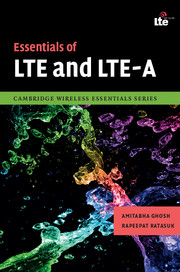Book contents
4 - Uplink transmission and system performance
Published online by Cambridge University Press: 05 August 2011
Summary
Introduction
LTE uplink provides an increase in capacity (both sector and cell-edge) by a factor of 2–3 compared with previous UMTS high-speed uplink packet access (HSUPA) systems at substantially less latency. This enables efficient support of high-rate data services such as FTP, HDTV broadcast, and HTTP as well as delay-sensitive services such as VoIP and video streaming. In LTE, several technological enhancements have been introduced in the uplink air interface to enable this improvement. They include orthogonal uplink transmission from intra-cell users, frequency-selective scheduling, shorter subframe size, support for 64-QAM modulation, multi-user spatial multiplexing, subframe bundling, semi-persistent scheduling, fractional power control, inter-cell interference control, and efficient control channels.
- Type
- Chapter
- Information
- Essentials of LTE and LTE-A , pp. 77 - 138Publisher: Cambridge University PressPrint publication year: 2011



